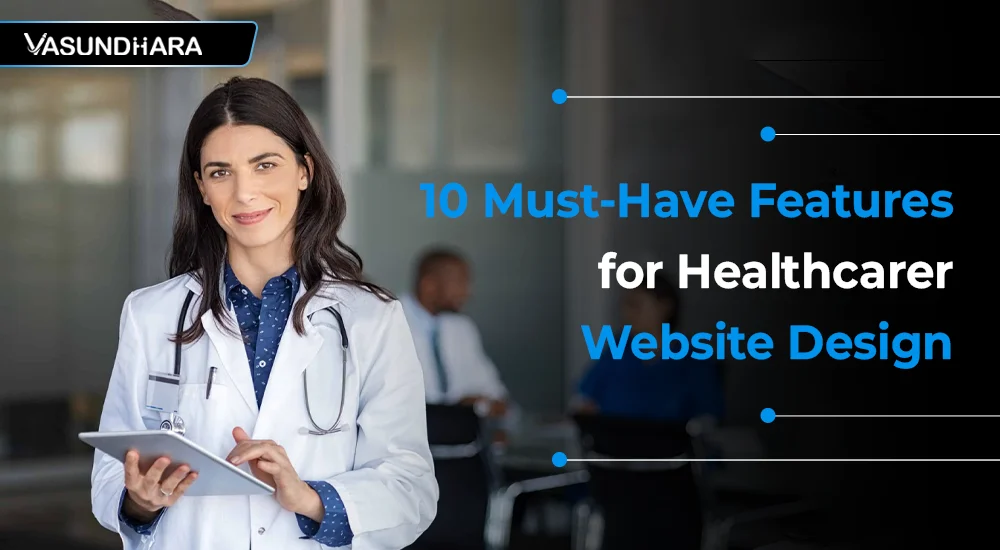10 Must-Have Features for Healthcare Website Design


- Jun 28, 2024
In the past few years, digitization has entirely transformed how individuals access health services. With the introduction of new technologies and innovations in healthcare services, such as healthcare web development, most patients commence their voyage by comparing and searching for online service providers. They anticipate discovering a healthcare application, website, or platform that is both user-friendly and distinctive to assist them with their healthcare inquiries. That’s why having a hospital website for your healthcare business has become essential.
The market has become increasingly dependent on maintaining a digital presence in healthcare. As a leading custom website development company, we at Vasundhara Infotech understand the importance of creating digital solutions that cater to the evolving needs of patients and healthcare providers alike.
Read this blog to know the top 10 must-have features you should include in healthcare website development.
67% of patients prefer to submit their appointment forms online. Therefore, the initial impression of your clinic is made by a medical web app, healthcare websites, or online scheduling platform, regardless of whether you are a healthcare specialist or a startup. It is imperative to exhibit it in a manner that will enhance consumer interaction and conversion.
The initial step is investing in an electronic health records (EHR) system. This system will simplify the process of storing and accessing patient records, thereby eliminating the necessity for staff to manually manage and update them.
Investing in patient scheduling and billing software is another cost-saving measure. It will automate appointment scheduling and invoicing management, thereby reducing manual data entry and overhead costs associated with staffing.
Finally, contemplate investing in telehealth technology. Telehealth systems enable patients to obtain medical care from the comfort of their residences without expensive office visits.
Focusing on the user experience is the secret to developing an exceptional hospital web application. An application that is user-friendly and simple to navigate should meet the patient's requirements. It should also be visually enticing and informative, with a straightforward, concise design.
The content should be well-organized and easily accessible, emphasizing the hospital's distinctive qualities, including its services, staff, and other distinctive features that distinguish it from its competitors. Incorporate a secure, dependable platform that guarantees the privacy and security of patient information and establish a website that emulates all competitors.
The website can disseminate information regarding your services, advertise special offers, and interact with consumers. Additionally, social media can be employed to establish connections with current patients and attract new ones. Lastly, paid advertisements can be implemented to enhance visibility and target the appropriate audience.
These strategies can potentially enhance your overall success and expand your audience. Additionally, by integrating the website with CRM, you can send emails to clients directly from the system.
Also read: Key Steps To Develop a Successful Healthcare App From Vasundhara
Healthcare web apps, whether platforms or websites, might vary depending on the functionality required.
As the healthcare business evolves and digital technologies become more common, healthcare organizations must give their patients with web applications that include a wide range of functions to improve the quality and accessibility of healthcare services. The following is a list of recommended features for medical online applications.
It is imperative to offer a user-friendly entry form that ensures a seamless and convenient user experience, enabling visitors to easily schedule an appointment with the doctor after being impressed by the plethora of information available on the healthcare web application. This straightforward measure will enhance patient satisfaction and result in an increased number of scheduled appointments. A win-win situation for both the patient and the healthcare organization!
Google Analytics makes it easier to assess how well your company is doing. Owners of businesses will find this solution helpful in tracking user behavior and analyzing web pages, traffic sources, and other marketing data. You can use a specialist to incorporate this function into medical web development, customize it to your company's requirements, and maximize your benefits.
Optional add-ons include a video tour of the property, a reception entry module, a prepaid payment module, a help chatbot, and other useful and practical services.
Give patients access to an essential search window so they may get all the information they need when they browse the web for information. Before proceeding with the consultation, visitors typically check for affiliation details and credentials to see if your online store is legitimate.
Video consultation has evolved into a feature that facilitates direct communication between patients and physicians. This function enables patients to receive high-quality medical care from various health professionals without having to leave their homes.
Today, video consultations and telemedicine are indispensable components of hospital web applications. It is possible to offer it as a distinct service or incorporate it into your facility's web platform. Ensure that you seek a web development company that will tailor the service to the specific requirements of your business. This feature can be effectively implemented and a user interface can be created without any complications with the assistance of experts.
In addition to appointment scheduling, medical web applications and online hospital platforms can be optimized to manage payments and bills, which are also critical duties. To achieve this objective, healthcare organizations must establish a user-friendly online payment system compatible with various payment methods, such as credit cards, PayPal, Payoneer, Google Pay, Apple Pay, and others. It has the potential to simplify the payment process, guarantee that your facility maintains control over its accounting, and offer patients a convenient and stress-free experience.
Healthcare organizations must effectively market their expertise to establish and preserve visitors' trust. Utilize your healthcare web application to introduce your team of medical professionals and emphasize their experience, education, specialization, and other pertinent qualifications. This type of Who's Who can be seamlessly integrated into the medical app or your website, enabling patients to conveniently locate and schedule a visit with a specialist within a single user journey. Ultimately, this will improve the patient experience.
Including social media into your medical website platform is an effective way to reach a wider audience, draw in more clients, and improve customer engagement. By utilizing the extensive reach of well-known social media sites like Facebook, Instagram, Twitter, LinkedIn, and others, healthcare organizations can disseminate informative materials, advertise events and services, offer client assistance, and cultivate enduring connections with both patients and the general public.
Personal medical information is safeguarded from unauthorized access and shared following the Health Insurance Portability and Accountability Act (HIPAA).
Developers of healthcare web applications and hospital systems adhere to cybersecurity enhancements to mitigate the risk of unauthorized access to health data.
Hiring web developers with experience in healthcare is crucial, as this will ensure that the most effective practices in data encryption, access control, and information management are implemented from the outset, saving you time.
Also read: Reasons Why Your Hospital Needs A Healthcare Mobile Application
The selection of features and technologies can influence a project's development costs, as each business's requirements are unique.
The most straightforward method for determining the cost of platform development is to "multiply the total number of development hours by the hourly rate of a web developer."
The final cost of a healthcare web design and development project depends on various factors, including the complexity of the project and the team's selection and location. It is important to consider that the cost of outsourcing to a healthcare web development company in the United States is generally higher than in other regions.
Vasundhara Infotech, a company with delivery facilities in Eastern Europe, offers the most advantageous value for money. The average hourly rate for web developers in this region is approximately $50, which is considerably lower than the average rates of $150 in the United States and $100 in Western Europe.
Also read: A Comprehensive Breakdown Cost of Healthcare App Development
Vasundhara Infotech is the perfect partner for healthcare software development services as a result of our expertise and adaptability. We have the requisite capability to effectively address a broad range of web development challenges, as our roster includes full-stack developers, front-end developers, project managers, designers, and more. Our multifaceted team is prepared to produce exceptional outcomes, regardless of whether your project necessitates the development of a comprehensive web application or integrating new features and functionality into existing systems.
Web development for healthcare is one of our primary competencies. We can create healthcare web applications of any complexity while adhering to the rigorous standards and regulations unique to the healthcare sector. Additionally, we specialize in seamlessly integrating these applications with other critical systems, including email services, CRM platforms, and payment gateways. Not only does this integration improve the functionality of your healthcare web application, but it also guarantees a seamless and efficient user experience for both your staff and clients.
Developing web-based healthcare solutions necessitates knowledge, appropriate experience, and strict adherence to crucial technical criteria, as such solutions deal with sensitive health data and help to answer life-threatening concerns. That's why, during healthcare web development, we prioritize cybersecurity, accessibility, dependable data storage and interchange, and adherence to local healthcare sector requirements.
We have expertise in healthcare and provide solutions that meet crucial current areas of the healthcare business. We guarantee the greatest time management and results-based implementation for small, mid-sized, and corporate healthcare projects.
So, what are you waiting for? Get in touch with our experts today.
Copyright © 2025 Vasundhara Infotech. All Rights Reserved.
